|
My Imme
Refurbishment of my Imme (note: lots of pictures, download can take a while)
2016 meeting of the Imme Freundeskreis in Immenstadt
Imme company pictures
Imme company drawings
Imme 1950
As I am very interested in (motorcycle) technology, motorcycles with unusual technical solutions alwyas draw my attention. This makes for some types of motorcycles that I directly want to add them to my collection at the moment I see them. A clear example of this is the Imme R100. Because Immes are very rare in the Netherlands (before my own I had never seen one!) it has taken a long time, but now the moment is finally there.
The Imme is designed by Norbert Riedel. You can see that this man was not afraid for unusual solutions on his 2nd famous design: the Victoria K20 "Swing" with electric gear shift mechanism. He has designed the Imme short after the 2nd World War. Because raw materials were very scarce at that time, it has become a minimalistic design that has no parts that are not really necessary. This made that the Imme clearly deviates from a "standard" motorcycle. Here a few important characteristics:
- The frame consists of only 1 bent tube, that runs from the headstock to the pivot point of the swingarm.
- The front fork is in fact a parallelogram fork, but the fork itself is single-sided and also consists of only 1 bent tube, of the same diameter as the frame tube.
- The swingarm is also single-sided and consists of 1 almost straight tube, that also serves as exhaust pipe!
- Due to the single-sided front fork and swingarm the wheels could not be mounted as usual. Instead the axes have been mounted on 1 side only. In fact this is comparable to the wheel mounting of a car.
- The wheel mounting is made so that the bearings, drum brakes and drive sprocket are fixed permanently on the front and rear axes. The hubs of the wheels are in fact not more than hollow bushes, that are pushed around the actual hubs on the wheel mounting, and fixed with 3 bolts. This makes that a wheel can be demounted and installed again on the motorcycle in just a minute!
As the hubs of front and rear wheel are the same, the 2 wheels are interchangeable. This made it possible to carry along an (optional) spare wheel, that was installed on the side of the luggage rack next to the rear wheel. Unfortunately my Imme does not have this option, which is unique for a motorcycle.
- As the swingarm is also the exhaust, the engine has been fixed to the swingarm. When the motorcycle dives into its rear suspension, the engine moves with it! This is also one of the characteristics of the Victoria Swing, which name is even derived from this fact. An advantage of this construction is that the chain slack is constant when the motorcycle dives in.
As the swingarm expands during driving due to the hot exhaust gasses, the chain slack decreases. Therefore there should be enough slack with a cold engine. Tensioning the chain is done by shifting the engine a bit forwards on its mounting points on the swingarm.
- In first instance the crankshaft was only a half crankshaft, with 1 crank and a "flying" big-end suspended on 1 side only. There was also only 1 shaft end that was carried by bearings in the left side on the engine casing. This is clearly visible in one of the company technical drawings that I have.
Unfortunately this construction turned out to be too weak, and gave a lot of problems. To solve this it was changed into a more conventional crankshaft with double sided bearings. This has been constructed so that it fits into the existing crank case. The only modification that was required (except from the crankshaft itself off course) was another cover of the crank space on the right side. Instead of the simple steel cover this part also became the bearer of the 2nd bearing. Nice detail is that this extra bearing is also the only "normal" ball bearing in the whole engine. All others are bearings with loose balls or rolls!
Engines with a double crankshaft can, apart from the already mentioned right engine cover, be recognised
on a capital "D" behind the engine number. Note: the D is not directly behind the engine number, but on a distance of a few centimaters. Fortunately my Imme has such a modified engine.
- The gear box has 3 gears, but no neutral! When the engine is turning but you don't drive, you have to keep the clutch disengaged. Fortunately there is a little ratchet that you can turn around to block the clutch lever in the disengaged position.
- Because the engine moves up and down, foot operated gear shift is not practical (suppose what happens when you ride through a hole during shifting). Therefore the Imme is equipped with manual gear shift, operated by a rotating handle on the left side of the handlebars. Indeed, the same as on many mopeds and scooters from the 60-ies and 70-ies!
Also in the interior of the engine it is clear that Riedel has tried to use as little as possible raw materials. The whole engine is a very compact construction, and to realise this some things are again done different that standard.
Due to the simple and compact construction of the Imme the total weight is only 57 kg!
I have bought my Imme in Germany, and the original license paper (in Germany called "Kraftfahrzeugbrief") is still with the bike. According to the license the motorcycle is already built in 1950, but put into use not earlier than October 1952. At that moment the production was already stopped. In 1955 the motorcycle has been transferred to an other owner, and in November 1959 it has been delisted and the license cancelled. Thus the motorcycle has only been used for 7 years!
Obviously the motorcycle has always been stored in reasonably dry conditions, as it was still in a good condition. Unfortunately the right engine cover (with the air filter inside) has been taken off and got lost, and the battery (which is of a special triangular shape) had been removed. Further the motorcycle looked quite complete.
Here a few pictures of how the bike looked when I bought it:
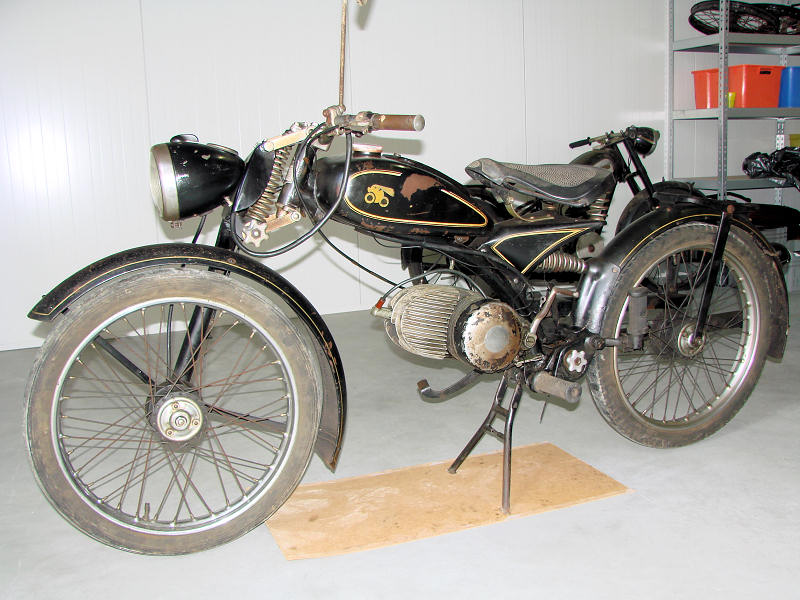
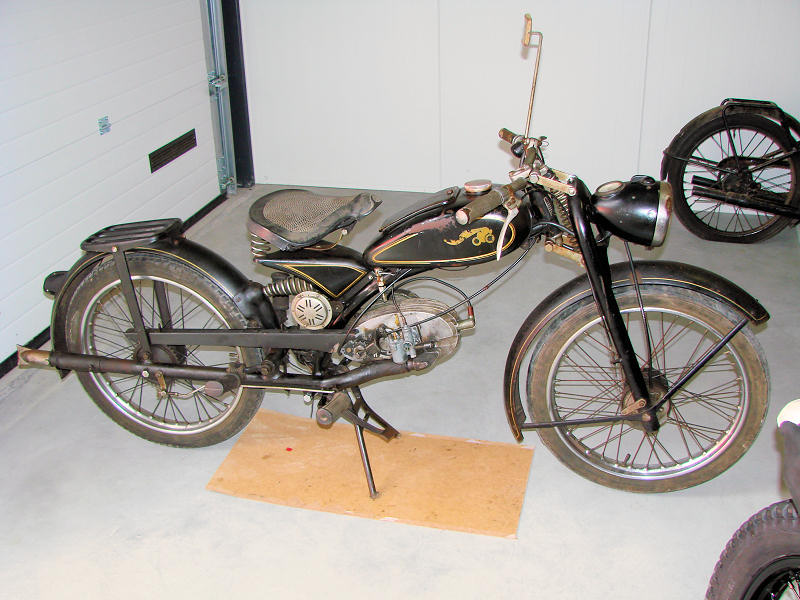
As it was still in a good state, I decided to keep the bike in its original condition instead of doing a total restoration. I have completely dismantled it, brought it back in perfect technical condition, and polished all paint and metal parts. The same as I have done with my 125cc Hulsmann from 1951 (story in Dutch). For those interested I have made an overview of this whole process of refurbishment, with a lot of pictures (note that it can take some time to download).
Off course there were some disappointments and troubles during the refurbishment, but with the great help
of the Imme Freundeskreis or in English "circle of Imme friends" (especially of engine specialist Werner!) the total operation has been succesfully completed.
After the refurbishment my Imme looks like this:
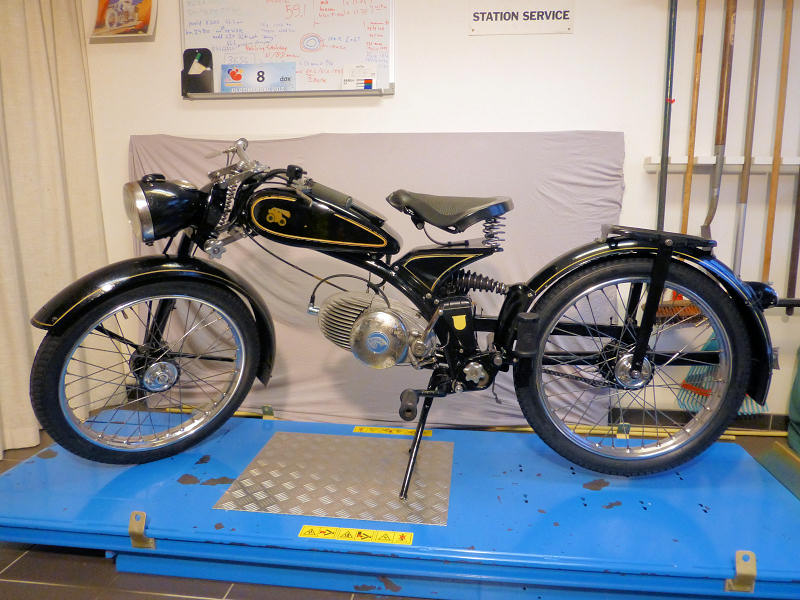
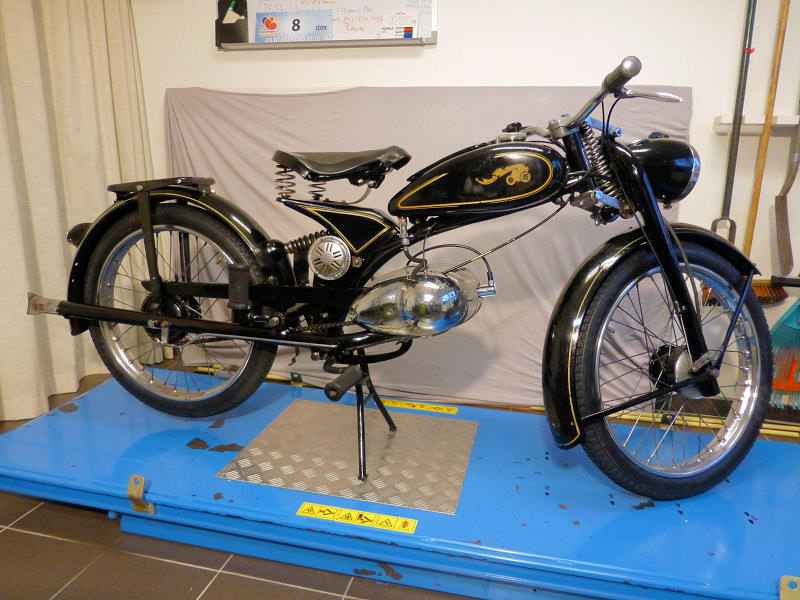
Now I finished it is winter time, and thus the weather conditions are not really suited for a test drive with such a nice historical bike. So I don't know yet how it runs! I can hardly wait until the weather gets better and the salt has been rained away!
Now a bit more information on the Imme R100. 3 different versions have been built:
- The Standard version. At first instance this was the only model, and it has been sold from 1948 till probably 1951. The colour was always Oxide-red and only a few smaller parts were chromed.
The battery was first a normal rectangular model, and mounted next to the frame on the right side. Between the frame tube and the rear mudguard was a triangular toolbox.
Later some modifications have been done, and then the toolbox was built in the top side of the tank, and the battery became the special triangular model, placed where the original toolbox was. A bit later the Imme also got its center stand, the first models had a side stand on the right.
- The Export version, sold in 1950 en 1951. This version had a bit more chromed parts and a speedometer, and was also available in black and green.
- The Luxus version, also sold in 1950 and 1951. This had even more chrome than the Export version, amongst other the rims, hub covers and the cover of the electric horn.
As is visible on the pictures, my Imme is thus the Luxus version. Lucky me!
The next picture shows how the total chassis has been built:
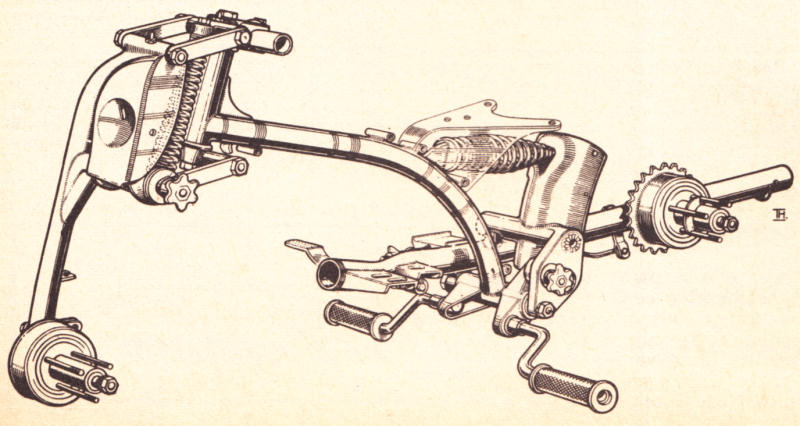
Image coming form the Dutch magazine "Weekblad Motor", no. 51/52 from 1969.
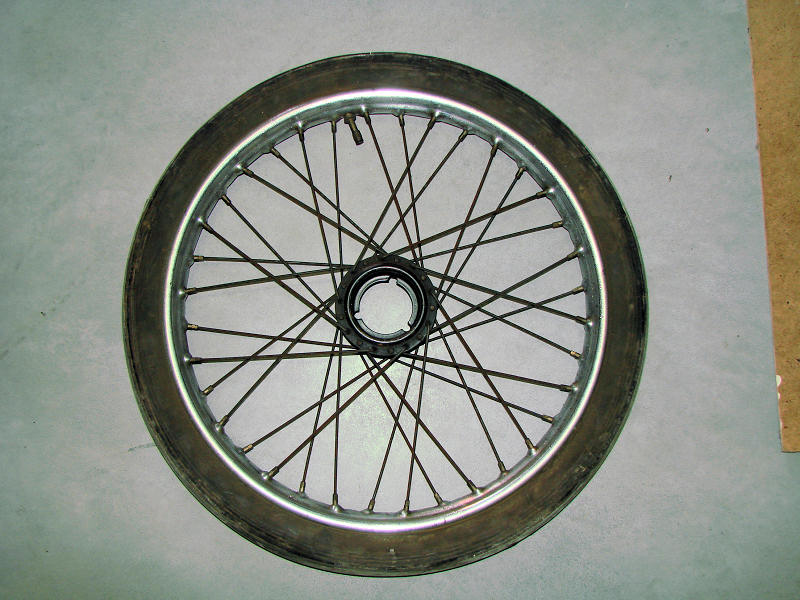
Here the wheel, the 3 notches fall over the pins on the hubs (see the drawing above)
The total construction of the engine can be seen very nicely in this ghost view, which comes from the owners manual of the motorcycle:
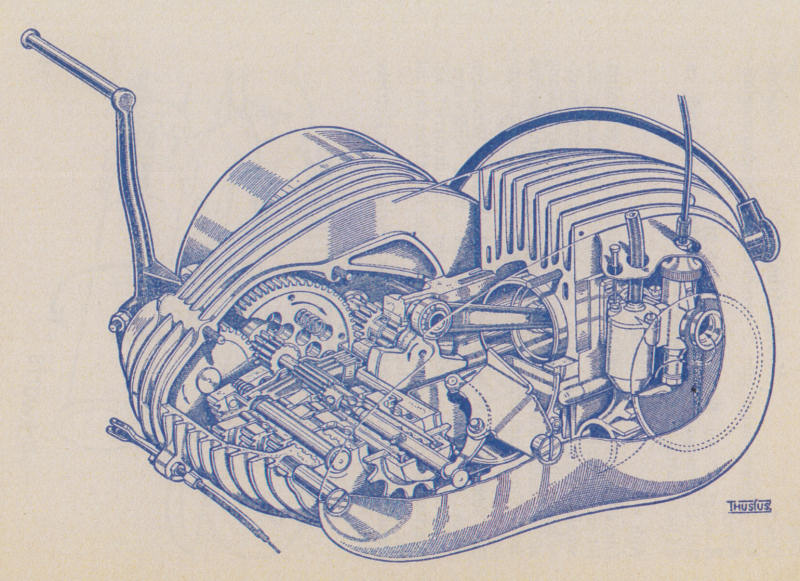
In the German magazine "Motor und Gasturbine" from October 1949 an article has been published about the construction details of the Imme engine. This article explains how Riedel has solved some issues in his own way. Remarkable is that he often used steel balls, for instance to block cog-wheel on axes. This has also been used in the gear box, which uses the so-called "pull-wedge" (in German "Ziehkeil") principle. Compared to a "standard" gearbox with sliding engagement dogs it needs far less parts, which helps to keep the engine compact and light.
This article also shows very clear how the original single sided crankshaft looks (click here to see the total article):
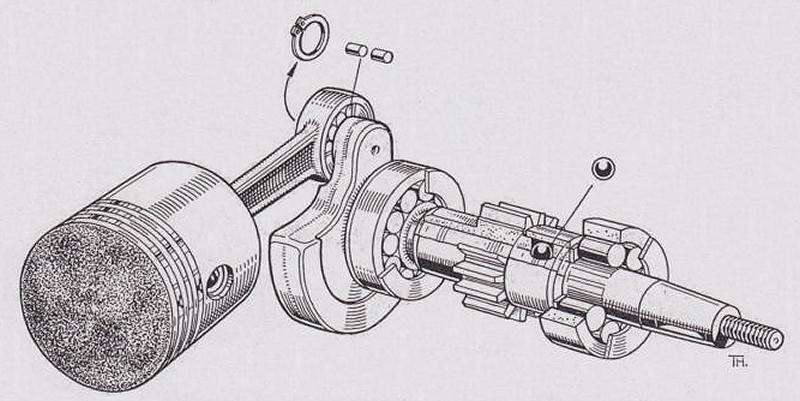
The original "half" crankshaft with single sided bearings
Here some pictures of the original crankshaft from my own Imme, to show how the double bearing crankshaft has been constructed.
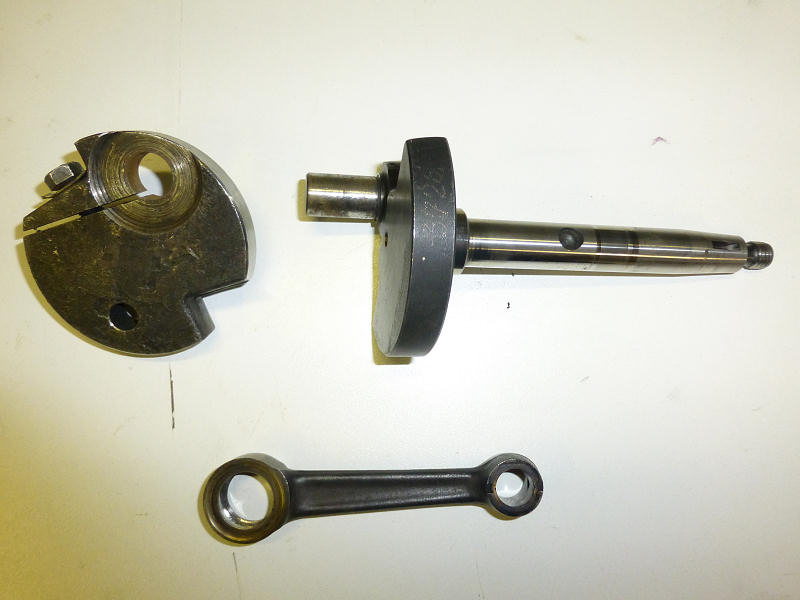
The loose parts. The 36 bearing rolls of the big-end are not on the picture.
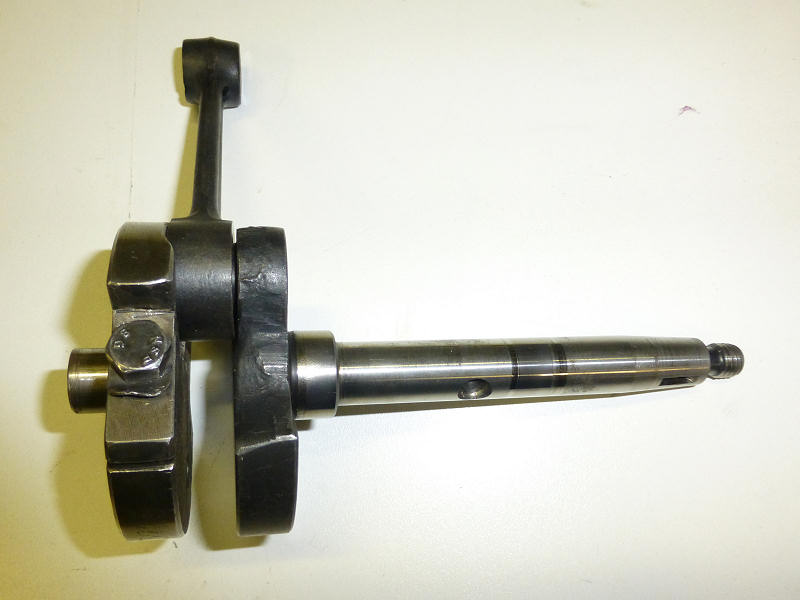
The complete crankshaft
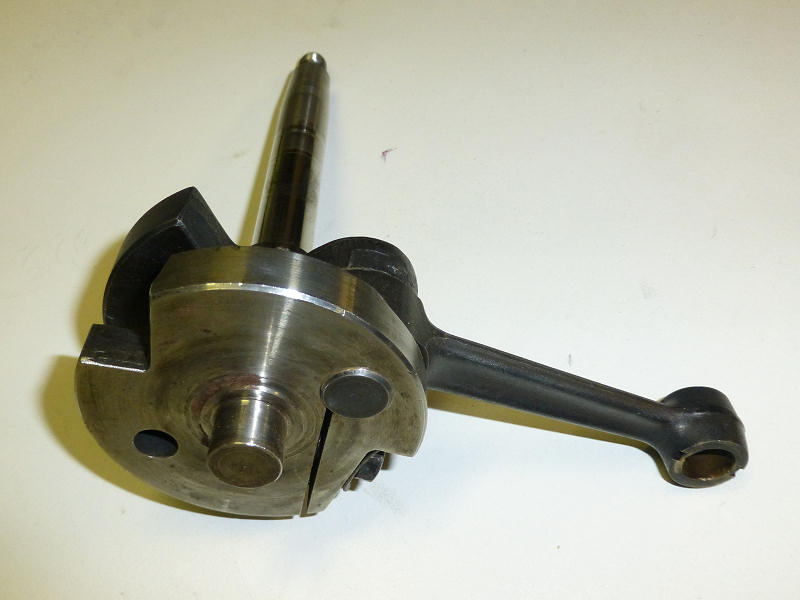
The loose 2nd half of the crankshaft. Note the clamping construction.
Here an image of an Imme in Oxyde-red with spare wheel. The spare wheel is mounted on a plate with 3 bolts, that is welded to the (modified) left support of the luggage rack.
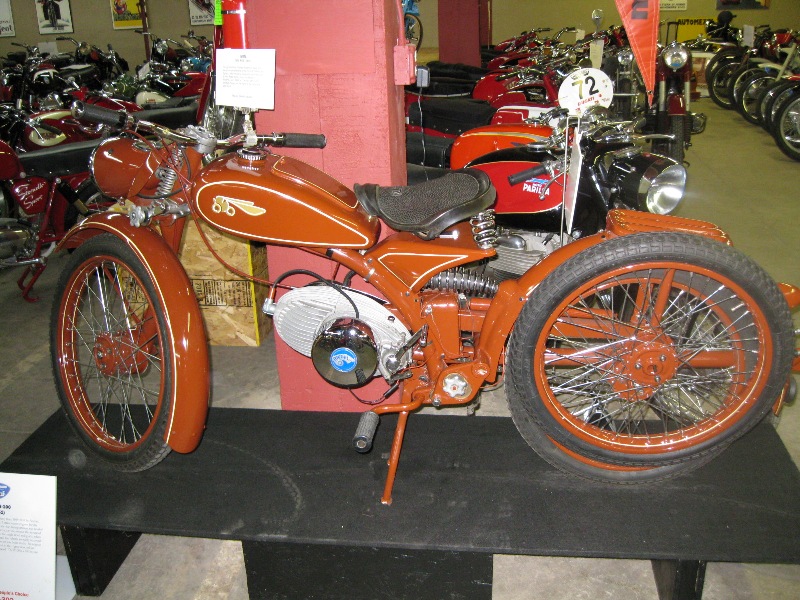
The triangular "box" under the rear spring is the battery, which was especially produced for the Imme. The next picture shows the
normal battery of the first Immes, mounted on the right side. Underneath the spring the triangular tool box is visible.
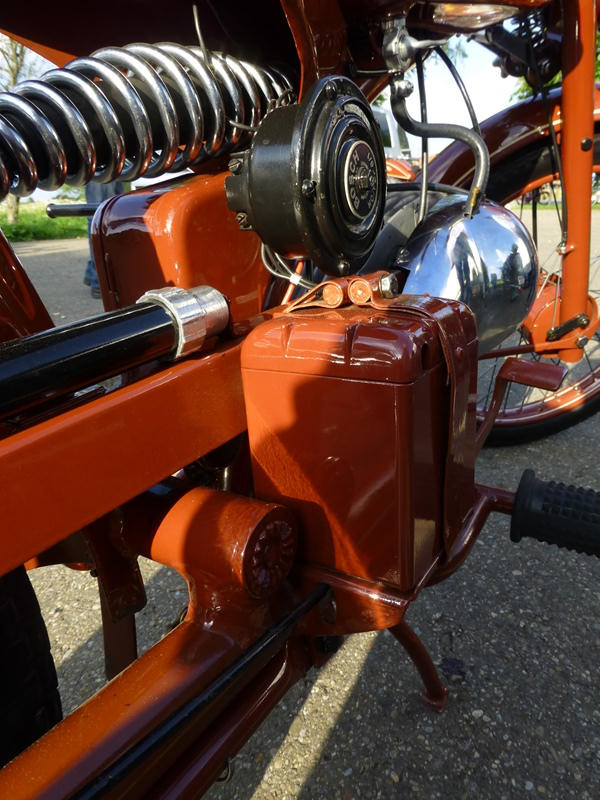
I have some original company pictures that were handed over to motorcycle magazines to illustrate their articles about the Imme. One of them shows Norbert Riedel, concentrating on his work:
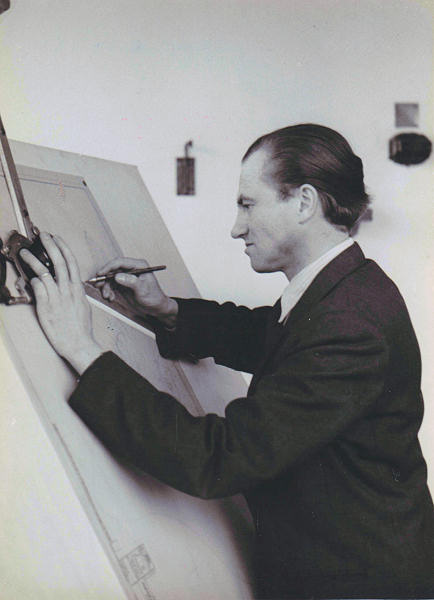
Click here for more pictures.
Next to pictures, the company also distributed technical drawings made by Thusius. I also have a few of these, like this one that shows how the brakes function:
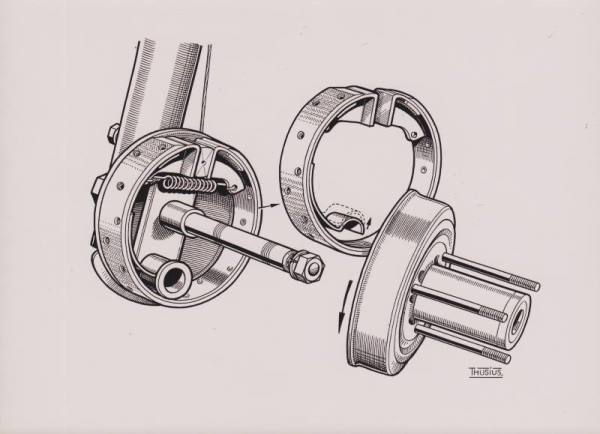
Click here for more drawings.
The Imme is also part of another part of my motorcycle hobby: motorcycle stamps. I could not (yet) find an official stamp with an Imme, but there is a First Day Cover (FDC) with an Imme:
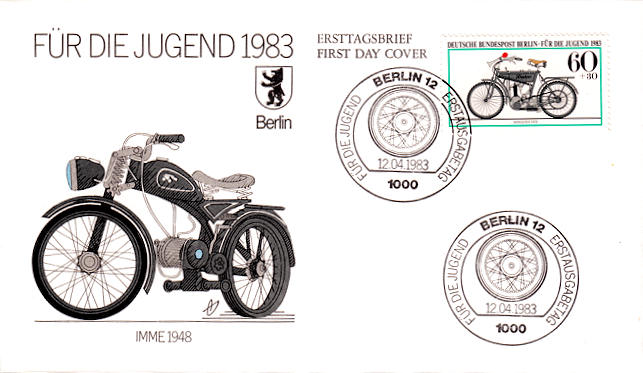
This envelop has been made for a series of 4 stamps for the youth, issued in Berlin in 1983. On the stamps are images of a Hildebrand & Wolffmüller, Wanderer (the stamp on the envelop), DKW Lomos and the Mars with 2-cylinder boxer engine.
Nowadays in many countries
the Post offers the possibility to make your own stamps, and off course I did this, just like with all my other motorcycles):
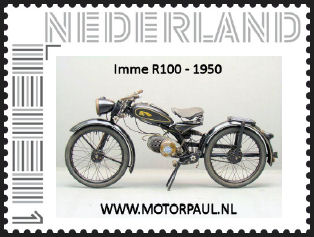
(picture not of my own Imme)
Also some artists are caught by the unusual design of the Imme. On the internet I found 2 drawings. The first made by the Frenchman Kkrist Mirror. He is a cartoonist who likes motorcycles, and offers T-shirts with one of his Imme drawings (and other motorcycles).
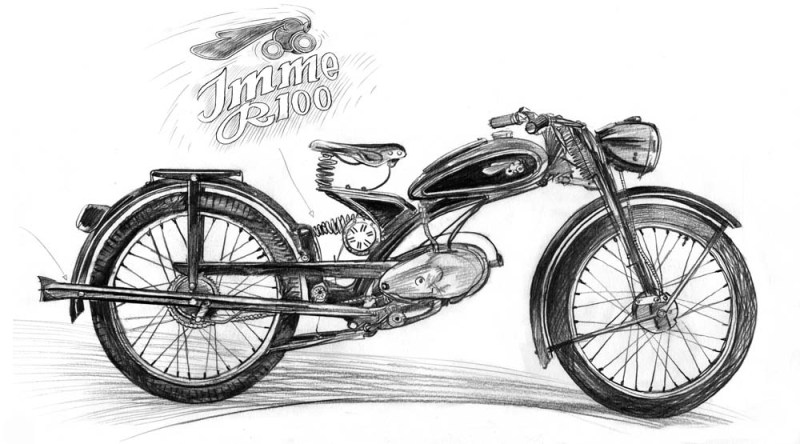
The second is made by Martin Squires, who draws motorcycles and many other vehicles like cars, tractors and steam engines.
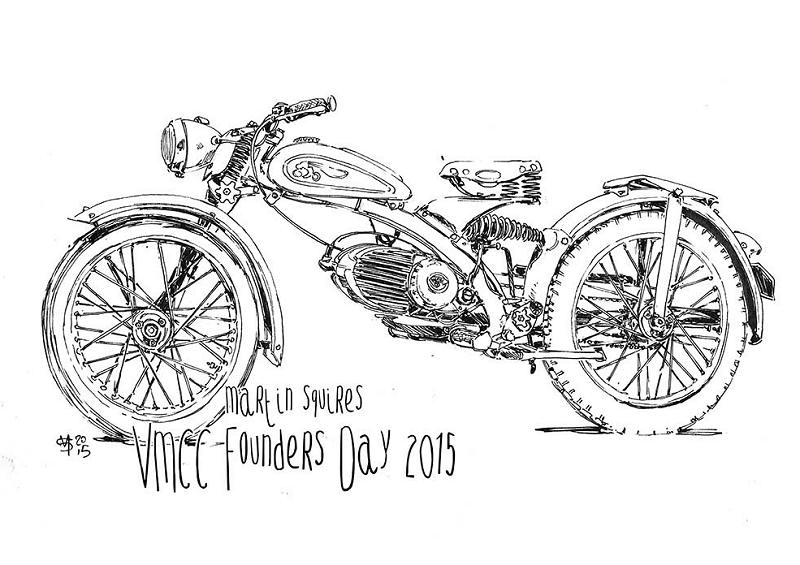
Note that also on this Imme the battery is missing!
|

